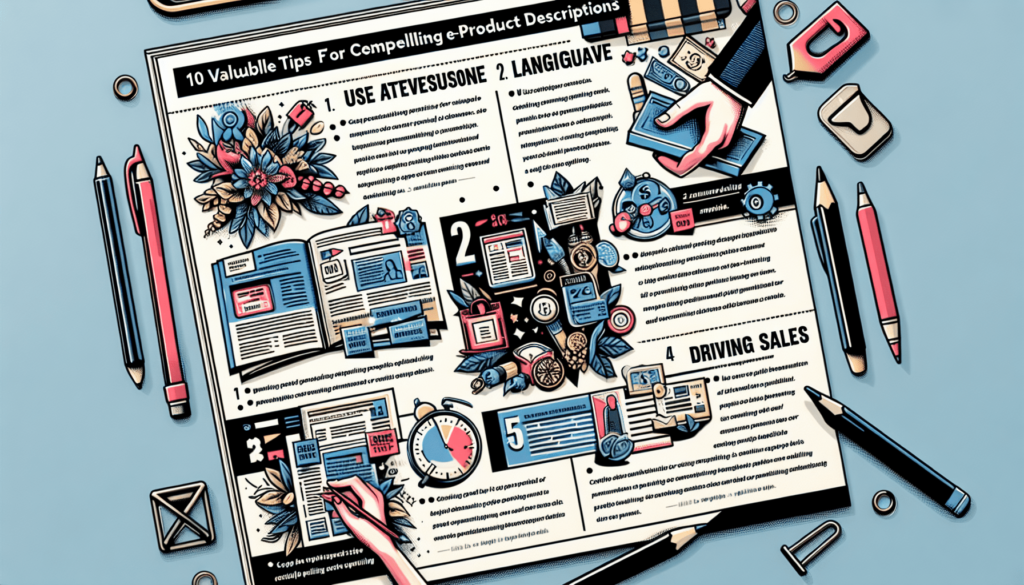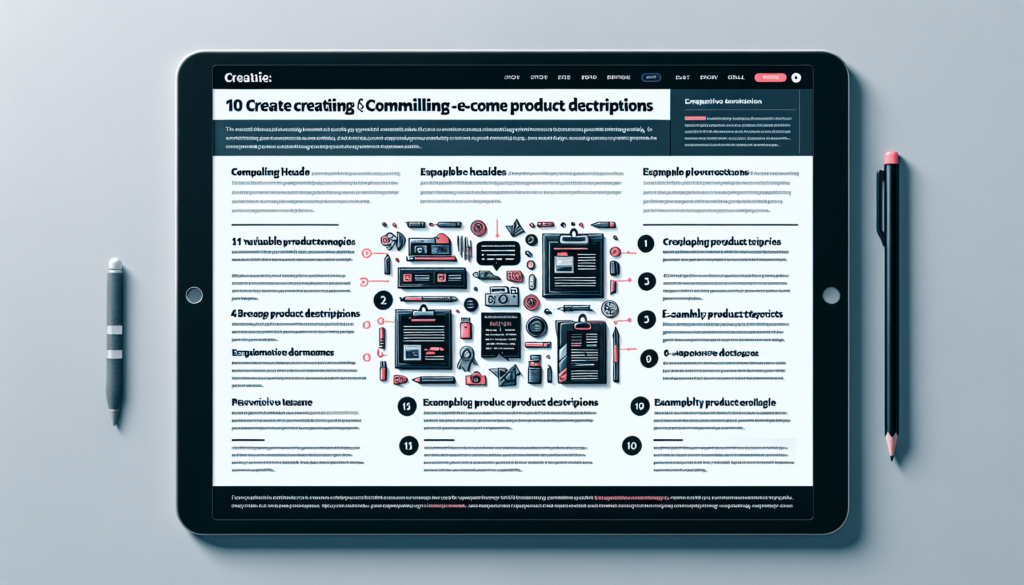Are you looking to enhance your e-commerce product descriptions and boost your sales? Look no further! This article provides 10 valuable tips that will help you create compelling product descriptions that captivate your target audience and encourage them to make a purchase. From understanding your target market to using persuasive language and incorporating visual elements, these tips will guide you towards creating irresistible product descriptions that will take your online business to the next level.
Know your target audience
Understanding your target audience is crucial when creating compelling product descriptions. By researching and identifying their needs and preferences, you can tailor your descriptions to appeal directly to them.
Research your target audience
Start by conducting thorough research on your target audience. Explore their demographics, interests, and purchasing behaviors. Look for patterns and trends that can help you understand their motivations and preferences. This research will provide the foundation for creating effective product descriptions.
Identify their needs and preferences
Once you have a clear understanding of your target audience, focus on identifying their specific needs and preferences. Ask yourself questions like: What problems do they have that your product can solve? What features or benefits would they find most appealing? By answering these questions, you can better align your product descriptions with their desires and expectations.
Tailor your product descriptions to appeal to them
Now that you know who your target audience is and what they want, it’s time to tailor your product descriptions to resonate with them. Use language and tone that speaks directly to their needs and desires. Highlight how your product can fulfill those needs and make their lives better. Remember, the more you can connect with your audience on a personal level, the more likely they are to be engaged and interested in your product.
Use clear and concise language
When it comes to writing product descriptions, clarity and conciseness are key. Avoid using jargon and technical terms that might confuse your audience. Keep your sentences and paragraphs short, making it easier for your customers to understand and digest the information.
Avoid jargon and technical terms
Not everyone is familiar with industry-specific jargon or technical terms. To ensure your product descriptions are accessible to a wide range of customers, avoid using language that might confuse or alienate them. Instead, use simple, everyday language that anyone can understand. If you must include technical details, provide explanations or definitions to make them more accessible.
Keep sentences and paragraphs short
Long, complex sentences can be overwhelming and difficult to read. Break up your text into shorter sentences and paragraphs to make it more manageable and visually appealing. This will help your customers skim through your product descriptions quickly and find the information they’re looking for without getting lost in lengthy paragraphs.
Use bullet points or numbered lists to highlight key features
Make your key features and benefits stand out by using bullet points or numbered lists. These formats are easy to scan and comprehend, allowing your customers to quickly get an overview of the product’s most important details. Highlight the unique selling points that make your product stand out from the competition.

Highlight product benefits
When writing product descriptions, it’s important to focus on how your product solves a problem or fulfills a need for your customers. Highlighting the benefits of your product will make it more appealing and persuasive.
Focus on how the product solves a problem or fulfills a need
Put yourself in your customers’ shoes and think about the problems or needs they might have that your product can address. Emphasize how your product can provide a solution or fulfill a desire for them. By demonstrating the practical value of your product, you can increase its appeal and convince potential customers that it’s worth purchasing.
Emphasize the unique features and advantages
What sets your product apart from the competition? Highlight the unique features and advantages that make your product special. Whether it’s a cutting-edge technology, a specific design element, or a high-quality material, make sure to showcase these selling points in your descriptions. Help your customers understand why your product is worth their attention and investment.
Explain how it can improve the customer’s life
Paint a picture of how your product can improve the customer’s life and make it better. Whether it’s by saving them time, enhancing their productivity, or adding a touch of luxury to their everyday routines, focus on the positive impact your product can have. Use language that evokes emotions and resonates with your customers on a personal level.
Tell a story
By creating a narrative around your product, you can engage your readers and make your descriptions more compelling. Use storytelling techniques to evoke emotions and connect your product to a larger context or lifestyle.
Create a narrative that engages the reader
Start by crafting a story around your product that captures the reader’s attention. Consider its origins, the problem it solves, or the inspiration behind its creation. By weaving together a narrative, you can make your product more relatable and interesting to your customers. Make them feel like they’re part of something bigger when they purchase your product.
Use storytelling techniques to evoke emotions
Storytelling is a powerful tool for evoking emotions in your customers. Use descriptive language and vivid imagery to create an emotional connection between your product and your audience. Whether it’s by describing how your product brings joy, solves a problem, or fulfills a long-held desire, aim to stir up positive emotions that make your customers feel compelled to buy.
Connect the product to a larger context or lifestyle
Help your customers envision how your product fits into their lives by connecting it to a larger context or lifestyle. Show them how it complements their personal style, enhances their hobbies, or aligns with their values. By positioning your product as a natural extension of their lifestyle, you can increase its appeal and make it more desirable.

Use sensory language
To make your product descriptions more vivid and appealing, use sensory language that appeals to your customers’ senses and imagination.
Describe the product using adjectives and sensory words
Bring your product to life by using descriptive adjectives and sensory words in your descriptions. Instead of simply stating its features, paint a picture with words that engage the reader’s senses. For example, instead of saying “soft fabric,” you could say “luxuriously soft fabric that feels like a gentle caress on your skin.”
Appeal to the customer’s senses and imagination
When describing your product, consider how it appeals to the senses of sight, touch, taste, smell, and sound. If applicable, describe the vibrant colors, the smooth texture, the unique scent, or the satisfying sound it produces. This allows your customers to imagine and experience the product even before they’ve made a purchase.
Create a vivid mental image
Use descriptive language to create a vivid mental image of your product in the customer’s mind. Help them imagine how they would use it, how it would look in their home, or how it would feel in their hands. By painting a clear picture, you can make your product more tangible and enticing.
Provide accurate and detailed information
Accuracy and detail are essential when it comes to product descriptions. Customers rely on this information to make informed purchasing decisions, so it’s important to provide them with all the necessary details.
Include essential product details such as dimensions, materials, and specifications
Ensure that your product descriptions include all the essential details that customers need to know. This might include dimensions, materials used, specifications, and any relevant technical information. Be clear and concise in presenting this information, making it easy for customers to understand.
Clearly state any limitations or requirements
If there are any limitations or requirements associated with your product, make sure to state them clearly. For example, if your product requires specific maintenance or has certain usage restrictions, communicate those clearly to avoid any confusion or disappointment after purchase. Honesty and transparency are key to building trust with your customers.
Avoid exaggerations or false claims
While it’s important to highlight the benefits and unique features of your product, it’s equally important to avoid exaggerations or false claims. Being honest and transparent with your customers will help you build credibility and maintain a positive brand reputation. Stick to the facts and avoid making unrealistic promises or overhyping your product.

Optimize for search engines
To ensure your product descriptions are easily discoverable by potential customers, it’s important to optimize them for search engines. By incorporating relevant keywords naturally into your descriptions, you can improve your search engine rankings and attract more organic traffic.
Research relevant keywords for your product
Start by researching relevant keywords that are frequently used by your target audience when searching for products like yours. Use keyword research tools or consult with an SEO professional to identify the most effective keywords to include in your descriptions. This will help you rank higher in search engine results and increase your visibility.
Incorporate keywords naturally into the description
Once you’ve identified the relevant keywords, incorporate them naturally into your product descriptions. Avoid keyword stuffing, which refers to the excessive use of keywords in an unnatural way. Instead, integrate keywords seamlessly into your descriptions, ensuring that they flow naturally and enhance the readability of your content.
Avoid keyword stuffing and maintain readability
While it’s important to include keywords, it’s equally important to maintain the readability of your product descriptions. Keyword stuffing can negatively impact the user experience and make your descriptions appear spammy. Strike a balance between incorporating keywords and creating engaging, informative content that is a pleasure to read.
Use customer reviews and testimonials
Leveraging customer reviews and testimonials can greatly enhance the credibility and persuasiveness of your product descriptions. By including snippets of positive reviews and highlighting customer experiences, you can build trust with potential customers.
Include snippets of positive reviews and testimonials
Take advantage of positive customer reviews and testimonials by including snippets in your product descriptions. Select quotes that highlight the unique benefits of your product and showcase your customers’ satisfaction. By sharing real-life experiences, you can enhance the credibility of your product and reassure potential customers of its quality.
Highlight customer experiences and satisfaction
When incorporating customer reviews and testimonials, emphasize the experiences and satisfaction of your customers. Share stories of how your product has positively impacted their lives or solved their problems. This builds trust and prompts potential customers to see themselves enjoying the same benefits.
Build trust and credibility
Customers often rely on the opinions and experiences of others when making purchasing decisions. By incorporating customer reviews and testimonials, you can build trust and credibility with your audience. Demonstrating that others have had positive experiences with your product can go a long way in convincing potential customers to make a purchase.
Add a call to action
To encourage potential customers to take action, it’s important to include a clear and compelling call to action in your product descriptions. This motivates them to make a purchase and provides guidance on how to proceed.
Encourage customers to take action with a clear and compelling call to action
Whether it’s “Buy Now,” “Add to Cart,” or “Shop Now,” include a clear and compelling call to action that prompts customers to take the next step. Make it easy for them to make a purchase by providing a direct link to the product page or a seamless purchasing process. Use persuasive language to create a sense of urgency or exclusivity, encouraging customers to act immediately.
Create a sense of urgency or exclusivity
To increase the likelihood of conversion, create a sense of urgency or exclusivity in your call to action. For example, you could use phrases like “Limited Stock Available” or “Offer Ends Soon” to encourage customers to act quickly. By tapping into their fear of missing out, you can motivate them to make a purchase sooner rather than later.
Provide a seamless purchasing process
Once you’ve motivated customers to take action, make sure the purchasing process is seamless. Provide a clear and intuitive user interface that allows customers to easily add products to their cart, review their selections, and complete the checkout process. Eliminate any barriers or complications that could deter customers from completing their purchase.
Proofread and edit
Before publishing your product descriptions, it’s crucial to proofread and edit them to ensure they are error-free and consistent.
Ensure proper grammar, punctuation, and spelling
Nothing tarnishes the credibility of a product description faster than grammar, punctuation, or spelling errors. Before finalizing your descriptions, carefully proofread them to eliminate any mistakes. Correct any grammatical or punctuation errors, and ensure that spelling is accurate throughout.
Eliminate any errors or inconsistencies
In addition to grammar, punctuation, and spelling, check for any errors or inconsistencies in your product descriptions. Ensure that information is accurate and up to date. Check that formatting is consistent and cohesive across all product descriptions. By maintaining a high level of quality and professionalism, you enhance the overall user experience.
Consider hiring a professional editor or proofreader
If you’re unsure about your proofreading and editing skills, or if you want to ensure the highest possible quality for your product descriptions, consider hiring a professional editor or proofreader. They can help you refine your content, polish your writing, and ensure that your descriptions are error-free and engaging.
In conclusion, writing compelling e-commerce product descriptions requires a thorough understanding of your target audience, clear and concise language, highlighting benefits, storytelling, using sensory language, providing accurate information, optimizing for search engines, leveraging customer reviews, adding a call to action, and proofreading and editing. By following these tips, you can create product descriptions that engage and persuade customers, ultimately leading to increased sales and customer satisfaction.
